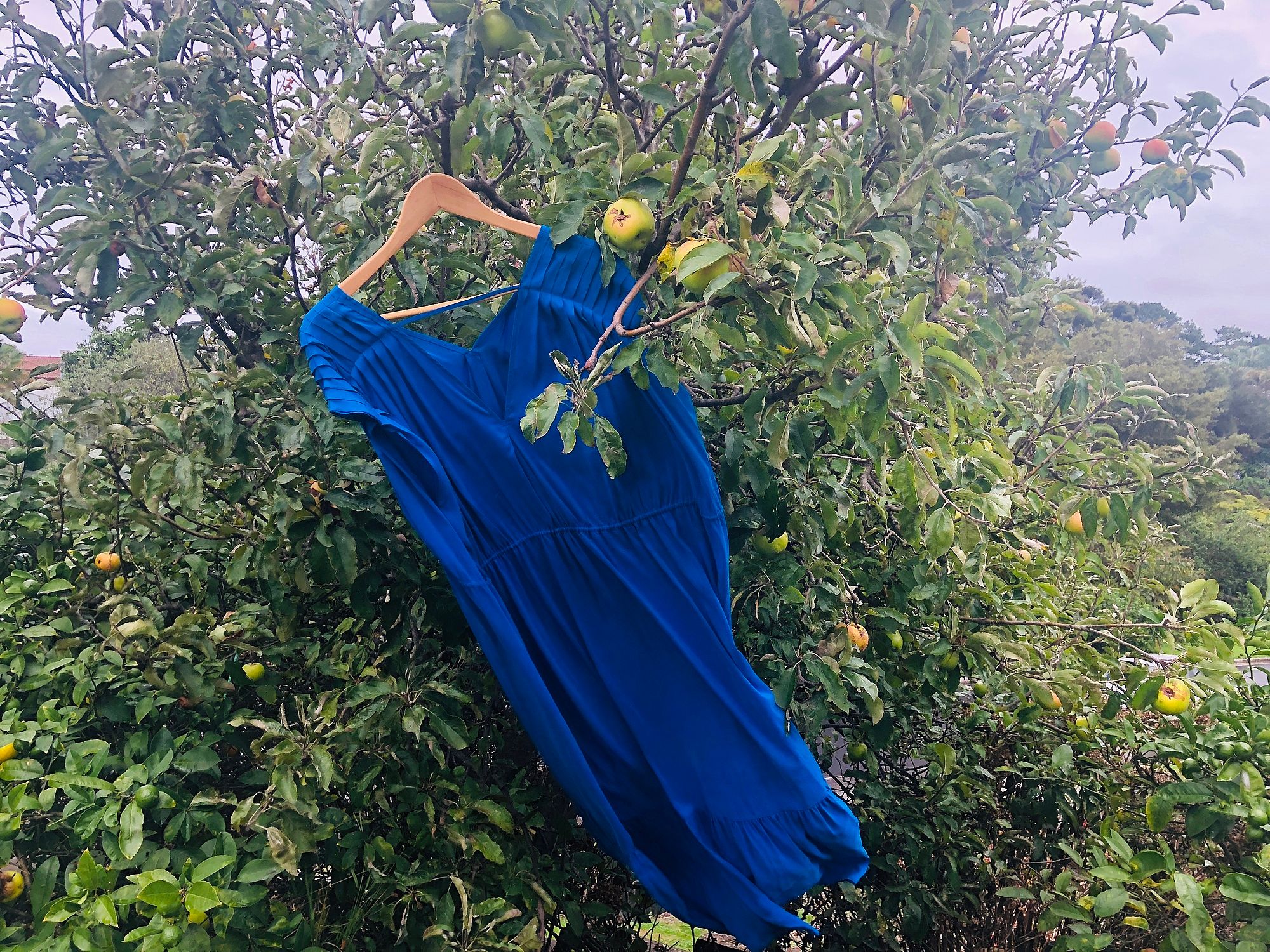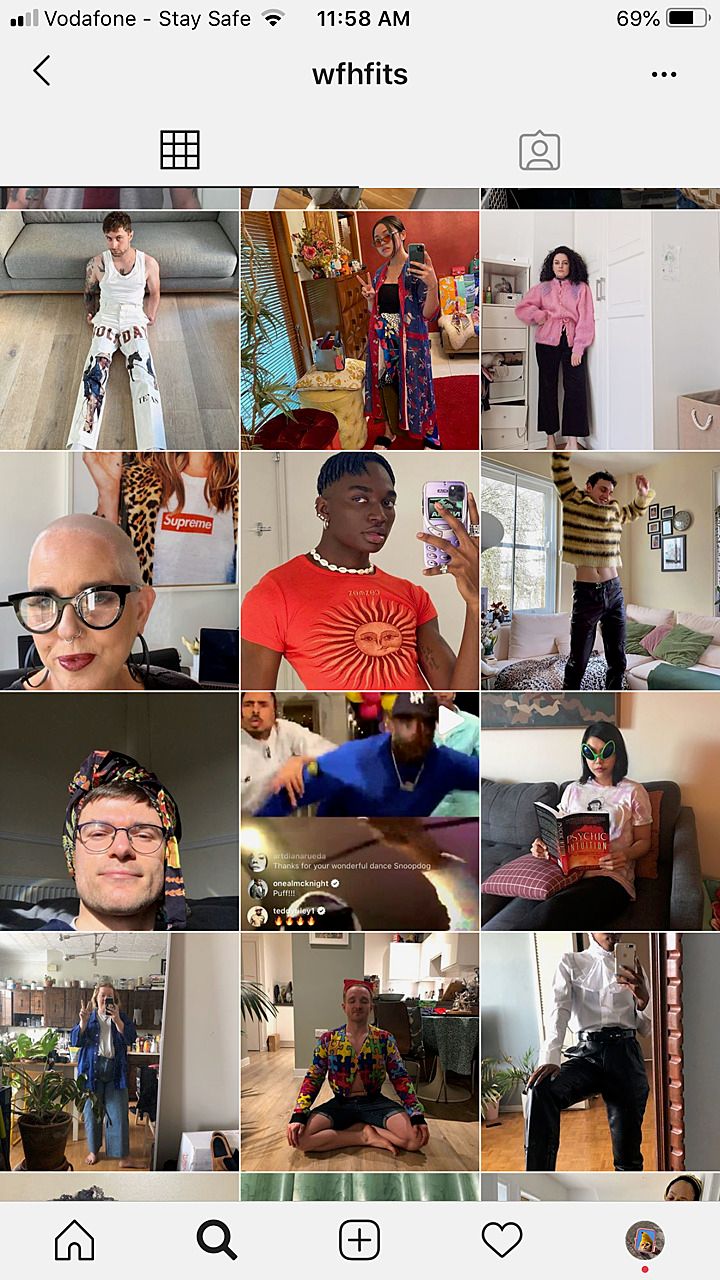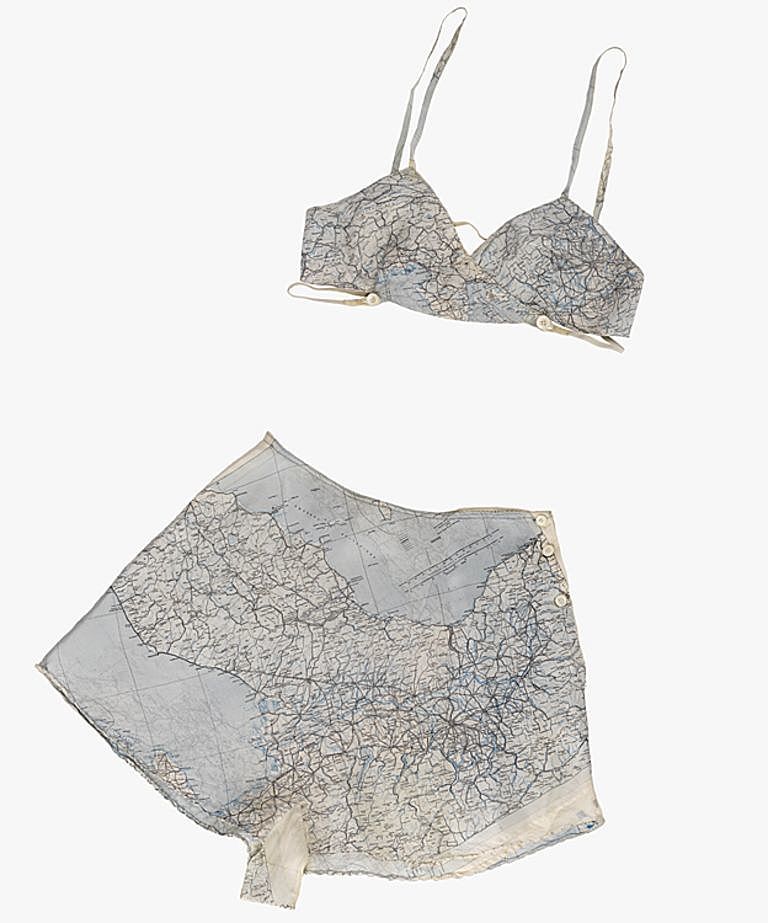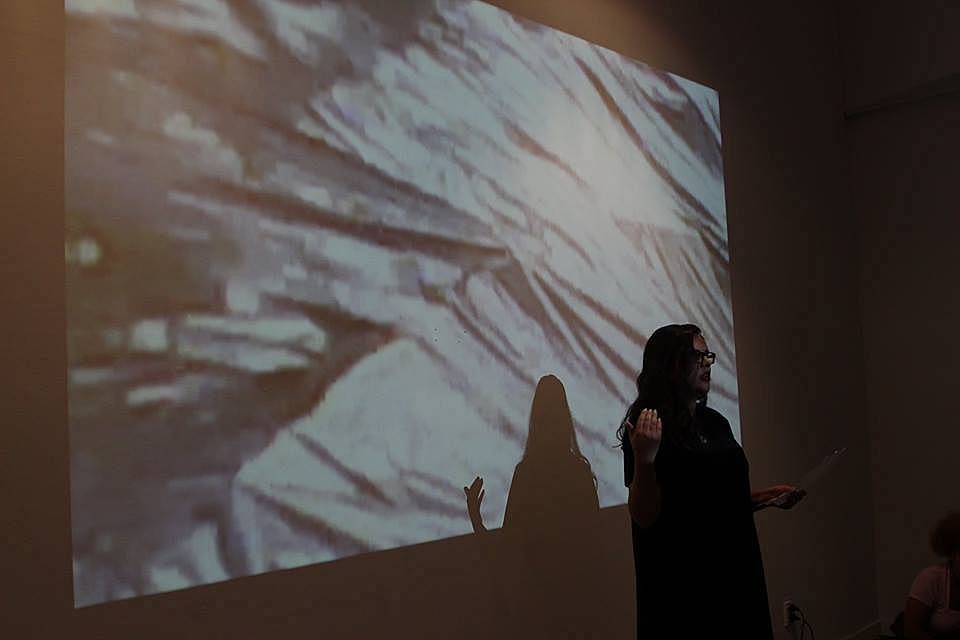How to Get Dressed in a Pandemic
On the absurdity and power of fashion during lockdown.
My part-time job has set me up with a monitor and phone, so I am now working from home, on a second-hand desk tucked away in a nook that was the spare room, but is now also an art studio. The walls are painted a soft cornflower blue, and behind the monitor is a print of the cover of a Tintin comic, and an empty glass bowl hanging in a macramé hanger. My mum’s celebrant notebooks are stacked neatly behind the screen.
During my first shift after our swap to Alert Level 4, I wore sweatpants, a Ramones t-shirt with a curry stain on the hem and mismatched socks, both with holes in the toes. I ran out of perfume a week before lockdown, so the only scent in the room was my own body and the burning of dust from the computer.
I had a terrible eight hours, full of connectivity issues: bad phone lines and slow internet. I felt unprofessional when I had to call the internal IT department, dirty and unkempt while I prattled away at my managers down my ill-fitting headset.
It was the exact same the following day, and the day after that. At the end of my third shift, I collapsed on top of my bed, twisted the comforter in my fists, and groaned wistfully in the direction of my open wardrobe doors. There hung all the clothes I’d not touch for the foreseeable future.
I’d forgotten the power of getting dressed.
It was my mum who knocked me awake, when I witnessed her change in attitude the minute she swapped out from her painting-the-fence shirt to a polka-dot blouse for a Skype meeting. She sat up straighter, was sort of more there, as if just by changing dress, she had disrupted the purpose of the space she was occupying. No longer was it the dining-room table cluttered with junk mail and spare glasses, where the cat likes to have a nap in the afternoon sun; it was transformed into her office, a place of educational authority. I’d forgotten the power of getting dressed.
Resolved, I tried this the next day I had to work. I wore what I would usually wear to the office – black pants, matching socks, a linen button-up and an emerald green cardigan. I put on some makeup, tidied my brows and took off the chipped aubergine nail polish. Styled my hair the best I could, given I’d needed a haircut before lockdown was even talked about.
The result was transformative. While all the issues that come with the sudden change of working from home still reared their irritating little heads, they no longer rubbed me raw, didn’t irritate the skin of my patience as much as they had. No longer was I making small mistakes, tiny errors in procedure.
I started to create new ‘work outfits’ again, now that I had effectively rediscovered my closet. With the weather starting to cool, I could dig out my jumpers, weird sweaters and cardigans, scarves and jackets. I could also be more wacky with it, going the opposite end of the spectrum without an enforceable dress code – I was now wearing my heavy silver rings and bangles again, hung hoops from my ears and draped my neck with pendants and cords. I dug out the Urban Decay palette I had bought duty free before Sephora shipped to New Zealand, and brushed the electric-blue pigments over my eyelids. I filled in my brows, framed my lips in the liner a friend had left at my house, painted my mouth firetruck red and matched my fingernails.
I wore my Miss Crabb dress yesterday, a silky mess of charcoal, just to roll around on my bed.
I stretched this out to my days off, too – I haven’t touched my sweatpants in days, and only throw on a t-shirt if I’m exercising in the garden. I wore my Miss Crabb dress yesterday, a silky mess of charcoal, just to roll around on my bed watching GTA V glitch videos and reading reviews on The White Pube.
I started to wash all my shirts by hand, soft fabrics in cold soapy water, and found shady spaces to dry everything flat. I cut loose threads off jumpers and dress hems, rolled a lint stick over jackets I had no intention of wearing for months, polished my Docs and wiped the collecting dust off my shoes.
My sudden rediscovery of my closet got me thinking, researching and unearthing a whole history of fashion I had no idea about. How we dress in times of stress, apocalypse and uncertainty. Clothing and jewellery, fashion and beauty have a rich and terrible history when it comes to pandemics, crisis and disease.
*
After the Black Death of the 1300s, those few Italians who survived, newly wealthy off the inheritance from relatives who weren’t as lucky, were blamed for marriage rates not ticking up again, as they were spending their dowries on luxury goods.
In the 1800s, ‘consumptive chic’ was the fashion of choice, with women’s dress imitating the willowy waists of those with tuberculosis, and the face to match was “a delicate, transparent skin, as well as fine, silky hair.” Later, when tuberculosis fell out of favour, the disease practically eradicated the trend for long Victorian skirts, for fear that they might catch germs in their folds.
And years later, when the AIDS crisis tore us apart, male designers of clothing suffered deep economic blows as the result of homophobia and “the fear that nobody would ever want to buy a blouse or underwear because it came from a designer who, in the mind of mass America, probably stitched each of those garments with his own diseased hand.”
More recently, Chinese designer Masha Ma had Swarovski-studded masks in her 2015 spring show in Paris. Gareth Pugh has long used masks in their creations, little touches of bondage and surgery.
I never thought ‘pandemic influencers’ would be a phrase I’d ever have to verbalise
And now, with Covid-19 an increasingly global pandemic, the fashion, wellness and beauty industries are once again being shaped by the fingers of paranoia, misinformation and modern-day influencers. Websites from Tatler to Elle have been posting a variety of corona-themed articles, from instructions on “How To Style an Epidemic” to “Six Different Beauty Tutorials to Wear Indoors”, because frankly, it’s the only place we’re going these days. And honest to god, I never thought ‘pandemic influencers’ would be a phrase I’d ever have to verbalise, but they are popping up all over Instagram.
Images via @CassandraRules (Twitter)
On one hand, this looks to be the foul touch of an opportunistic capitalism – a health crisis that threatens billions of lives is just another chance to make a quick dollar. On the other hand, it’s a timely reminder of what’s been proven over centuries: that we’ve long sought comfort in the snake oil that is fashion, especially when we can look good doing so.
The way fashion is adapting in real time is terrifying and hilarious – there are already fashion versions of hazmat suits, surgical and N95 face masks, and latex gloves, and there have been for a while. Punks getting creative and hand painting their masks to match their shirts, à la Mad Max or Blade Runner. Fashion students in Prague have been taking deadstock fabric and producing masks, sending the floral, polka dotted, striped, checkered and graphic printed masks to hospitals, retirement homes and voluntary organisations.
The luxury fashion conglomerate LVMH, which operates Louis Vuttion, Dior, Givenchy and more, had announced it would convert some of its perfume-making facilities to making hand sanitiser. Fellow conglomerate Kering (Balenciaga, Gucci, Saint Laurent and others) is making face masks for hospitals in France. The Gucci company itself donated one million euros (almost NZ$1.8 million) each to the Italian Civil Protection Department and the Covid-19 Solidarity Response Fund. Imagine, the uber-camp Gucci florals on a facemask, protecting hospital workers, frontline staff, as they carry out one of the most hazardous jobs in this crisis. A J’adore perfume bottle converted to dispense hand sanitiser.
Image: Instagram
Dedicated social media accounts are popping up all over – a current fave is Working From Home Fits, an archive of people’s outrageous and delicious outfits for the home office. We’re seeing internet personalites, from sex workers to meme makers, craft ‘pandemic looks’ – from hazard suits crossed with assless chaps to risqué bikinis made of surgical masks. The primary function of the object no longer exists, now reinterpreted as a fashion accessory, a crucial means to self-decorate in the global apocalypse.
*
It’s not the first time we’ve taken things from our daily lives – items of necessity, or even struggle or strife – and fashioned them into desirable accessories.
During the Great Depression of the 1930s, flour mills started printing floral patterns on their cotton bags, once they discovered mothers were making dresses and shirts for their children out of the sacks. Women would dry wildflowers from ditches and hang them in their open button-holes, pin them to their hats. Men would update their cotton shirts with new buttons, fashioned from found shells, bits of metal and plastic. The ultimate waste-not-want-not mentality.
The constant desire to accessorise, to self-decorate, to dress up, has persevered and outlasted entire countries
In the Blitz of World War 2, a variety of strange and persevering fashions arose. Bracelets and pendants fashioned from the metal and plastic scraps of crashed German bomber planes. ‘Siren suits’, early precursors of our modern onesie, were designed for men and women to slide into as they dashed from home to bomb shelter. The department store Selfridges started selling luminous flowers and buttons, so that people could decorate themselves in small touches of light, to reduce the number of pedestrians hit by cars during the blackouts.
Women even started making lingerie sets out of silk RAF maps; battle lines and landmarks riding the ridges of their bodies. Coats were made out of blankets and decorated with satin ribbon stitched on as hems. Handbags were designed that actually concealed gas masks.
The constant desire to accessorise, to self-decorate, to dress up, has persevered and outlasted the histories of entire governments, entire countries, seemingly immovable, eternal structures. Our innate craving to satisfy our own magpie nature will seemingly outlast even the lowest moments of humanity, as long as there is a humanity to carry on.
Artist Ann Hamilton says that textiles, and by extension clothing, are “the body’s first architecture”. Humans have always worn clothing, and not always for function. Sure, we skinned animals for cloaks to stay warm in the changing climates, the cooling nights; made accessories from leathers to hold, carry and cradle. But there was no functional purpose for us to have dyed them different colours, tied loose feathers into our hair, made a tassel, or hung shells and bone from our fingers and ears, wrists and neck.
The only purpose to doing so was that it pleased us, and that somewhere, deep in our animal history, we decided that pleasing ourselves with decoration was important to our survival. We drape ourselves in fabrics, textiles of all sorts, as a form of comfort, personal architecture, of engaging with something more ancient and primal than ourselves, but also as a way of covering it up, distancing ourselves from an animal nature.
We might argue our ability to create and design and build new looks for ourselves sets us apart from our animal family, elevates us as being more evolved creatures. As if there aren’t other animals out there that self-decorate, for a variety of purposes too – protection from predators is no small feat, nor are cosmetic alterations in attempts to catch a mate.
The bearded vultures of Central Asia have naturally white feathers, but rub themselves down in iron-rich soils, giving themselves a deep red and orange hue, to make themselves more desirable to each other. The older the bird, the deeper the colour, which suggests a form of social structure or hierarchy amongst the flocks. Flamingos, too, apply makeup during mating season – their pink hue is intensified, mostly due to their rubbing their natural carotenoid oil (which catches beta carotene from the little shrimps and larvae they consume) over their feathers. The avian version of makeup, or a tattoo. So, even animals love a little style.
We need to dress up to carry on living.
Essentially, our desire to dress ourselves, whether it be in some anti-fashion grey shirt and jeans à la Mark Zuckerberg, or a gaudy Molly Goddard monstrosity, is a base desire, a form of self defence. It’s a survival mechanism. We need to dress up to carry on living. And given that, right now, we can’t really leave our houses, throwing a few baubles at our bodily homes doesn’t seem to be the worst thing to do.
I suspect I am not alone in my longing to face this nightmare of seclusion in fancy dress, and my desire is certainly not without historical precedent. So I shall continue to pick myself up each morning, peel the sheets from my body, and put on my most expensive underwear, colour my eyelids in purple or maybe teal, stain my lips, and perhaps wrap my body up in lace and silk.
And maybe this terrible rage to live, to survive, is what I am responding to as well – a need for a bit of spontaneity in our restricted darkness – even if my adventures are confined to solitary walks in the near-empty rooms of my brick house, alone in my cascades of Cinderella-blue silk, my shiniest boots.




